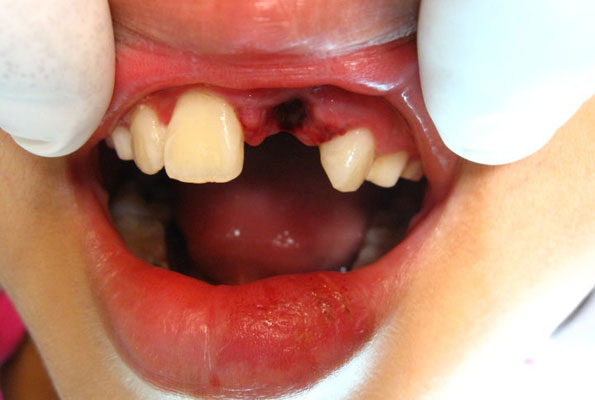Avulsed (knocked out) teeth
What is a tooth avulsion?
An avulsed tooth is a tooth that has been completely knocked out or removed from its socket. Teeth that have been avulsed can be saved, but require immediate treatment. Your best chance for success for adolescents is within 20 minutes.
Avulsed teeth are a dental emergency. Please see a dental provider immediately.

Can an avulsed tooth be saved?
The short answer is, yes. However, that depends on a number of factors, including time.
The prognosis for avulsed permanent teeth very much depends on the actions taken at the place of the accident. We want to promote and encourage public awareness of first-aid treatment for the avulsed tooth. Treatment choices and prognosis for the avulsed tooth are largely dependent on the vitality of the periodontal ligament (PDL), and the maturity of the root.
Avulsed baby teeth vs. adult teeth
If a baby tooth is avulsed, leave it out of the socket. Next, seek a dentist for a follow-up. Baby teeth should not be replaced; see first aid information below.
If the tooth lost is an adult tooth, you must act quickly in order to save it. Work quickly and calmly through our first aid instructions.
First aid for avulsed teeth
Knocked out teeth are a dental emergency. It’s important that you stay calm and act quickly. First aid begins at the place of the accident. You have about 20 minutes post-accident for the best chance of saving the tooth.
- Most importantly STAY CALM, and keep the child calm.
- If a tooth is avulsed, make sure it is a permanent tooth (primary teeth should not be replanted).
- Find the tooth and pick it up by the crown (the white part). Avoid touching the root.
- If the tooth is dirty, wash it briefly (max 10 sec) under cold running water and reposition it.
- If you are not the child’s guardian, encourage the patient and/or guardian to replant the tooth, if possible. Once the tooth is back in place, bite on a handkerchief to hold it in position.
- If this is not possible, (e.g. an unconscious patient), place the tooth in a glass of milk or another suitable storage medium IMMEDIATELY and bring it with the patient to the emergency clinic.
- The tooth can also be transported in the mouth, keeping it inside the lip or cheek if the patient is conscious.
- If the patient is very young, he/she could swallow the tooth. In this case, it is advisable to get the patient to spit into a container and place the tooth in it. Avoid storage in water.
- If there is access at the place of accident to special storage or transport media (e.g. tissue culture/transport medium, Hanks balanced storage medium (HBSS), or saline solution) such media is preferable and should be used.
- Seek emergency dental treatment immediately.
Trustindex verifies that the original source of the review is Google. Highly recommend! We've been going here for years now & I never have a complaint!Posted onTrustindex verifies that the original source of the review is Google. If you’re looking for a place that works well with kids I definitely recommend them, the staff is very welcoming and know how to make the visit fun and non scary for the kiddos! My kid leaves this place wanting to go back everytimePosted onTrustindex verifies that the original source of the review is Google. Dr Ngo and team are absolutely great with kids. They go beyond the usual cleaning and talk about jaw, bite, speech and oral health overall. We are grateful to have them local and our kids love going in!Posted onTrustindex verifies that the original source of the review is Google. Me encanta como tratan amos niñosPosted onTrustindex verifies that the original source of the review is Google. Great! took care and kept my daughter calm fast and detailed.Posted onTrustindex verifies that the original source of the review is Google. My son, had a great experience. They were great with my son who is four years old and he felt very comfortable. Great place to take your kids!Posted onTrustindex verifies that the original source of the review is Google. We have been coming to Kid Focus for years and absolutely love it!!!Posted on

